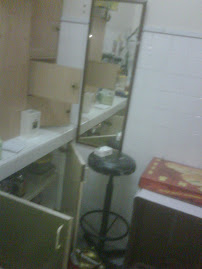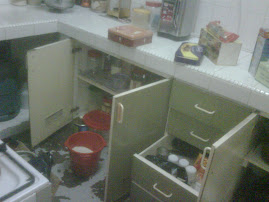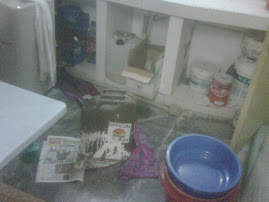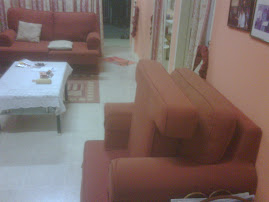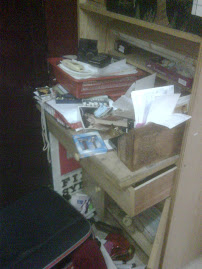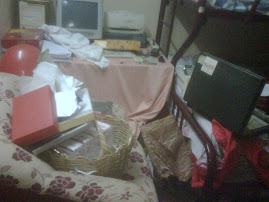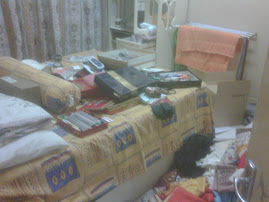Tuesday, July 12, 2011
NCER - REGIONAL ENABLER
‘At 30,000 feet nothing moves but we are on the ground.’ This is how the number main the captain’s seat of the Northern Corridor perceives action rather high-flying talk.’
- Datuk Redza Rafiq Abdul Razak
CEO of Northern Corridor Implementation Authority
Datuk Redza Rafiq Abdul Razak, the Chief Executive Officer of North Corridor Implementation Authority (NCIA) is no dreamer but a hard core realist with radical approaches to kick start and promote economic propulsion in a manner where the benefits are realised and enjoyed by those in his catchment area – Penang, Perak, Kedah and Perlis.
Malaysian Corridor had the opportunity to sit down with Redza and hear things from his point of view in a point blank manner. Redza was quick to use catch words like “regional enabler” and highlighted the “change in the approach” adopted by NCER.
In 2008 and 2009 Redza says the total figure given was RM1.48 billion. In 2010, he changed NCIA’s approach as previously they were doing infrastructure work and getting involved in the construction of roads, drains, bridges and so on.
“That’s not our job. That’s the job of the JKR and JPS. It only created complications. Our task now is how do we catalyse private sector participation and ensure that the private sector can thrive and prosper in this economic corridor and how we can manage the spillovers and that is to ensure optimal benefits?”
Redza prefers not to take the approach of being big planners. “We base our work on the reality on the ground for example the Sungai Kerang project and have started export in to Dubai and Saudi Arabia. These are on-going. Even for the bee hive venture, their factory will be ready in July. And as a regional implementation authority, we don’t get involved in say 30 acres in Bukit Dumbar for example. This is why you see our aquaculture which is so big.”
This is what Redza and NCIA are all about. The NCER has chalked up RM 9.3 billion through the total private sector participation alone over the past 16 months with RM3.3 billion bagged in the first four months of this year alone. Such is the record set by the NCER under the stewardship of its Redza. Since its inception, the NCIA has created nearly eight thousand work positions and led by the NCIA, private sector participation has outreached RM6 billion of which only 8.99 percent of it had constituted governmental input.
ACHIEVING THE OUTREACH
He centres his ideas on how best to optimise the economic benefits from these high value activities. If Redza pursues a portfolio approach to economic development he feels there will always be low hanging fruits which are of high yield. In the case of the Northern Corridor, Redza feels that a typical example of that is E&E sector (electrical and electronic) which can continue to achieve high economic status and attain the goals set in the New Economic Model.
“But we cannot use this as a portfolio approach to achieve economic development at the expense of other things because our agricultural sector provides the biggest outreach.
“On the one hand we have the biggest multiplier (E&E) sector and on the other hand the biggest outreach (agriculture).
Citing the Flora Bee Hive Enterprise, Redza find it’s a simple process in which the company promotes the use of bio-technology to get the bees to produce royal jelly.
“Royal jelly which is a higher end product (a small bottle can fetch up to RM100 plus and they are all mainly for export globally) when compared to honey is a product of a scientific process but the actual bee farming is just bee farming plain and simple where they don’t produce hone but royal jelly.
“If the ‘so what’ of this comes about, we are actually able to create business opportunities and from there we manage the spillovers and the downstream activities like the manufacturing of the boxes for the bees.
“The people at Flora Bee Hive do not sell a system like many other ventures like worms, leeches and so on. Their approach is that if you can find someone who can produce the boxes more economically than us, please go ahead. All they want is the royal jelly and this creates a lot of spillovers.”
Being quite passionate about how each venture provides the much felt outreach, Redza was quick to distance himself from infrastructure projects citing their one and only Penang Sentral project which is under construction is Penang Sentral The rest of their activities does not involve construction.
How the NCIA ensures local participation is that they engage with the local leaders who will them provide the funnel in terms of the candidates “because they are the ones who know the best.’
“We want best outcome based on the ground results and they (the leaders) have the best on-the-ground experience. This was successfully done in Tasek Glugor and Kamunting.
“We didn’t know the participants but the local leaders help us in managing the funnel.”
Confining his illustration and approach to the context of the bee hive farmers, the question of how NCIA prepares the participants came about.
“We give them training and the funding. It is not funded nor is it guaranteed by the government. It is done by the private sector and NCIA job is to catalyse the private sector to enable them to function that way. We don’t get involved with taxation and all that but we go one level down and these people get the loans and if they can’t repay the loan, the company will take back the businesses to repay the loans”
The motivation factor in doing this is the carrot at the end of the stick. With just two hours of work each day, a bee farmer can earn RM800 per month. So this can get bigger and bigger with greater involvement by the bee farmers.
The best part of this outreach programme is the anchor company (Flora Bee Hive) which buys the royal jelly produced by the farmers. This is opposed to having a retailer at the other end and the problem of branding, labeling and packaging will set in complicating matters. The anchor company serves as an industrial provider.
Reza encased local investment in the Northern Corridor to be 50.6 per cent of the 6 billion investments and the remaining being foreign and the bulk of the investment comes from the manufacturing sector. The Led player for example contributed 2.1 billion.
“That is why you cannot take the portfolio approach when reflecting on investment against companies and so on. You have to look at the yield factors and the outreach because whatever economic benefits that you want to get out of this, have to appeal to the masses who must be able to reap the benefits from such economic endeavours. This will answer the critics who would be tempted to ask ‘so what?’
“The two examples alone reflect RM2.6 billion and this is only two. The half a billion comes from Singapore-based aerospace company Aviatron.”
The NCIA, Redza says, works very hard at this especially in getting what is just below the surface which is RM40 million worth of contracts being farmed out to companies by a company like Aviatron but somehow this doesn’t get picked up. These are the real spillovers, says Redza.
What attracted Aviatron to the Northern Corridor is a 40-year evolution in manufacturing which started from the semi-conductor industry which provided a fixed set of baseline skills. These base line skills are important as the culture of delivering precision products and services was found in this region especially in Penang.
This had since become quite attractive to the companies and NCIA ‘s challenge was not so much in attracting them but the track record which the region has and these companies could literally come and see for themselves what is being done.
“It’s more show of capability to the NCIA. Redza feels that the challenge was more on how to carve out the RM40 million in spin-offs. It is different from Redza’s previous involvement in Cyberjaya which he described as a green field. Penang, he said, is a brown field and this remains NCIA’s strong selling points towards being able to deliver precision products for the past 40 years.
Redza does not deny that there had been failures in the past. He cited an example of a case of having two manufacturing lines which are super efficient.
CENTRES OF EXCELLENCE
“When they put in three of four lines, they can’t do it. What changed them from being super where the yield was 99.97 percent. The investors were impressed and went for five lines but the yield dropped to 95 per cent. Why does this happen. “
To cope with this problem NCIA has centres of excellence (COEs). Redza feels that some local companies do not have a structural discipline.
“They have the capabilities but do not have the structural discipline and this where the centres of excellence (COEs) will help them foster the spirit of COEs to move in tandem with the engagement.
“What helps us is that the work culture is already there to attract like-minded individuals and similar companies to help them get back on track.”
Redza says that the 40 years of evolution has created a culture of business found to most palatable to these companies especially with a history of delivering precision products for the past 40 years.
“They have all these segments of the supply chain that are done by the companies and with RM40 up for grabs this is not a bad thing. This serves to only strengthen and augment the state of being in the aerospace ecosystem in the Northern Corridor.”
This is something different, he quips.
Perhaps this is why things are done differently in the north with Redza at the wheels. He is very much down-to-earth.
“We are not the ones to announce big multi-million ringgit buildings to be built and so on.”
Redza was also quickly to divert the attention to another area of concern which is human capital development in trying to keep pace with economic development.
Penang hospitals for example, he says are choosy.
“The growth in the health industry sector is huge and is creating job opportunities for nurses and doctors so much so that the private institutions of higher learning are under pressure to revise the syllabus and increase their standards of qualification and meet the stringent guidelines set by the hospitals. These institutions of learning have to meet the stringent criteria set by the hospitals.”
The NCIA has also touched the hearts of paddy farmers with a scheme that became a sigh of relief and assign of higher yields in their crops.
This was the case in the area of fertiliser storage (setor baja) with their trays and the transplanters. NCIA designed this to get rid of the problem of empty husk paddy (padi angin).
Redza came to realise that the empty husked padi was being discarded and with the proper storage and dissemination of fertlilisers the farmers enjoyed a 10 per cent increase in their yield.
Directly or indirectly a simple move of efficiency benefitted 20,818 farmers because they could now access their fertilisers from a safe place and use it and use it when and where they want it without the fear of it getting wet or stolen as was the case in the past where they had to rush to use it which at one time resulted in poor quality paddy with a high incidence of empty husk
With the new storage scheme, the farmers recorded a 10.1 per cent increase in their income because of such a facility thought out by the NCIA.
Touching on tourism, Redza cited three main areas being eco-tourism, heritage and cultural tourism and the niche market tourism such as healthcare travel.
Redza hinted at Langkawi and Belum as tourism products being re-positioned somewhat and this plan is still in its concept stage.
“We just finished the first round of the Langkawi lab in which we are looking at how we are going to re-position. Why we didn’t report on this is that it sounds like we are going to re-position but looking to reposition are not repositioning yet. This is also the case for the Belum tropical rainforest and a study is still being carried out.
On cultural heritage tourism Redza was equally passionate about historical and traditional folklore that got lost as Langkawi developed into a tourist haven. This has never been propagated well and the story remains untold, say Redza who feels strongly that there are many tales of Langkawi which are priceless and can be marketed to tourists.
Redza has put on his thinking cap with this bit.
As for Penang, he says it is still the place where the hospitals are situated but ironically all the supporting industries are on the mainland. The producers of human capital are on the mainland. One of the key providers is in Seberang Jaya (Masterskill Nursing College) and another in Kedah (AIMST University).
“I don’t see Penang as the sole beneficiary of the healthcare travel and tourism. We are riding on the fact that Penang is just one of the two hot areas as far as health care tourism is concerned, the other one being in Malacca (Manipal Medical University).
CHALLENGES
Redza’s first challenge was to set the engagement direction in the right mode and manner and so he changed the overall approach.
The biggest challenge for Redza was to steer the NCER into what they are now doing and this involved a lot of maneuvering on his part as the captain of the ship and true to his grit and sheer good judgement battles are won and spirits remain high as the figures speak for themselves especially when the NCIA organised the Norther Corridor Bussiness Showcase in KL Sentral recently.
“Those some will say there is a political overtone, it is not the case. The economic corridors are designed in such a way that all the states are represented. There are no political interferences.
“In our case we work with MIDA. We do not have our own tax incentives as our engagement is different. We are the regional enabler and we work with Pemandu in a collaborative engagement and we basically work with our friends.
“We also liaise direct with factories like MDV for example which has never been done before. We come up with new innovative models like the Floral Bee Hive where have the private sector guaranteeing the loans which before this, we normally hear of only the government doing that.
“The unique nature of this is not just about the royal jelly, honey or whatever but the model that we use to extract value out of this. This is private sector land and in the 10MP, the private sector is supposed to drive economic growth. This is it.”
The US remains the single largest foreign investor nation in the Northern Corridor and the investments centre mostly in the E&E sector.
On his next biggest challenge, Redza says that if the Northern Corridor remains status quo, Malaysia will lose out to other countries.
“This is where we hope to institute programmes so that we can move up the value chain and continue to be competitive so that investors can continue to see the NCER as a viable business location and as a water tight value proposition for them.
“Take AMD as an example of this. They have a test facility now compare to assembling and IC packaging in the past. With the new test facility, it becomes a service and it is to improve the local content of our exports.
“This means that we have more value captured in the country and the jobs being offered for this are also highly paid jobs. They now hire technicians and engineers to conduct this testing. And this is where they enter into an agreement with us and are compelled to provide the training for our graduates allowing a transfer of technology. This is a way completes the value chain.”
Citing another example in QAV Redza says the company is not labour intensive but it creates 1,000 spillover jobs from companies supporting them. QAV on its own, he says, is not labour intensive. The definition of labour intensive jobs is now subjective.”
“In Redza’s previous engagement in Cyberjaya, there was a belief that with more computers there would be less manpower but it was proven otherwise as with the increase in computers the more people had to be engaged. It became human capital intensive. The test facility at ADM requires 700 people meaning 700 jobs which are high-tech jobs which are highly paid.”
The Northern Corridor speaks for itself. It is indeed a brown field in nature and they cannot compare themselves with other corridors as each corridor has its own value proposition and its own way of doing things.
The beautiful part of the corridor structure is that all the mentris besar and chief ministers are represented in the council and their state secretaries work closely with the NCIA to deliver the initiatives.
“There are no political issues. We have clear KPIs on what we are doing and what we are going to do. I really don’t believe in blowing the trumpet about what we are going to do. I would rather we get it done first. That is why we take a conscious effort to manage this secondary impact at the spillovers. That has to be managed. The challenge is how we carve out and manage all these value-add to remain in the country.
“You need to find the right activity which is practical and has high value in order to provide higher income levels to the masses. It is about what approach we use to harvest such high value like the Flora Bee Hive venture.”
Flora Bee Hive is an example of a value proposition for the regional roll out for the industrial production of royal jelly in Perak and Penang and Perlis and Kedah soon to follow suit. They have created 600 business opportunities along with 20 jobs in their Kamunting factory.
The NCIA is also being used vigorously by Pemandu and as their regional enabler for the EPPs (entry point projects) in the northern area, Redza also sits in the NKEA (national key economic areas) steering committee.
“This (NCER) is also a programme and we (NCIA) have to make sure that it is carried out. When you talk about transformation, are we not transforming?
“I am a strong believer of the EPPs as I am personally involved until its implementation. QAV is parked under an EPP and QT is part of a catalyst which forms another EPP called L Foundry. We are involved and we are strong believers of the NKEAs. These are not plans but programmes. You see, at 30,000 feet nothing moves but we are on the ground.
Ends.
BACKGROUNDER: The NCER as the regional development initiative encompasses the states of Kedah, Perak, Perlis and Penang in the north of Peninsular Malaysia and leverages on the advantages of the region by emphasising on formulations of growth in areas of agriculture, manufacturing, logistics and tourism which has become the primary focus of NCIA to ensure that social and sustainable development objectives are kept as priorities while stimulating economic growth.
Each company in the corridor is committed towards contributing to the development of the region and brings with them unique products, services and offerings that are unrivalled. The projected gross national income (GNI) from the region is expected to reach RM 13.03 billion and the NCIA is well on track to meet the goals of the region and that of the NKEAs that it supports. The growth of the GNI in the NCER is expected to play a key role in helping the nation realise its goal of achieving high income status by 2020.
The NCER is the only economic region in Malaysia that benefits from its forty years’ of inductrial and manufacturing evolution and its continuous success has contributed directly towards the availability of commercially viable land, sound infrastructure, an in-built business culture and an entrepreneurial mindset.
Official launch: Tan Sri Nor Mohamed Yakcop, Minister in Prime Minister’s Department, Economic Planning Unit (left) and Dato’ Mukhriz Mahathir, the Malaysian Deputy Minister of International Trade and Industry (second from left) officiating at the Northern Corridor Business Showcase. Looking on is Datuk Redza Rafiq Abdul Razak, the Chief Executive of the NCIA (centre behind Yakcop and Mukhriz).
Booth signage: Tan Sri Nor Mohamed Yakcop, Minister in Prime Minister’s Department, Economic Planning Unit (right) signing on one of the booths at the Northern Corridor Business Showcase. Looking on is Dato’ Mukhriz Mahathir, the Malaysian Deputy Minister of International Trade and Industry (second from right) and Datuk Redza Rafiq Abdul Razak, the Chief Executive of the NCIA (third from right).
Interview session: Siva Kumar, the Editorial Adviser to Corridor Development Corporation Berhad (right) and Zainal Epi, Editor of Malaysian Corridor Magazine (left) was interviewing Datuk Redza Rafiq Abdul Razak, the Chief Executive of the NCIA (middle) on the business showcase.
Ends.
Monday, August 16, 2010
50 REASONS WHY IT WILL BE DIFFICULT FOR BN TO SECURE A CONVINCING VICTORY
Wednesday, May 19, 2010
‘Project Sunshine’ changes life in the longhouse


A longhouse resident (pic above) making an international call from
The solar installation on the far right (pic below) on a hillock overlookingthe Kerapa Spak longhouse (left)
IBC COMPLETES SOLAR HYBRID SYSTEM IN
KERAPA SPAK, BETONG
The system dubbed SHS (solar hybrid system) was installed at a feverish pace over a period of four months by IBC Solar Teknik Sdn Bhd, the main contractors who are in a joint technical co-operation with Sarawak based Carbon Capital Corporation Sdn Bhd.
The German based technology, reputed to be the best technology in the solar industry was realised in Kerapa Spak at a cost of RM4.5 million – a cost which is protected by its quality and durability.
The IBC system complies with Europe’s IEC 616 standards wherein power output is guaranteed for 25 years – a definition which spells out the fact that capability does not drop more than 80 per cent failing which the supplier would have to replace the product.
These are the IEC standards upheld by IBC when they did their installation at Kerapa Spak which would have far–reaching effects on the capabilities of the longhouse folk in this particular locality.
The Chief Exectuive Officer of IBC Solar Teknik Ahmad Nazri Ibrahim said that in addition to the lighting -up of the longhouse, the surrounding area’s street lighting, the community area and church have also been lighted up.
“With power comes everything else and among the possibilities that have already made its mark is the pre-paid satellite uplinked telephony system,” he said.
“Longhouse folk are now practically queueing daily up to use the pay phone as they can call anywhere in the world and it will be a matter of time before they join the cyber world with internet access and broadband capabilities besides installing Astro TV.”
Nazri has his reasons for selecting Sarawak and as he puts it, “It is my conscientious belief that after more than 45 years of independence with Malaysia, our brother and sisters in the remote interiors of Sarawak and Sabah are somewhat detached and isolated from mainstream infrastructure development.”
“How are they to develop if they keep on living in such isolation occurring naturally or by design, I wonder.
“They still have no power, limited power in most places, no clean and piped water, no digital information super highway vide the internet and in my honest view, this is completely unacceptable if you see it against the background of a nation trying to scramble for a developed nation status.”
The installation at Kerapa Spak features the construction of a solar house, putting up of the solar modules, inverter, load and battery banks which take up to 40 per cent of the cost. Work was also hampered by the accessibility as most of the things had to be taken up river on five to six-hour longboat rides from Pengkalan in Betong.
The irony however was that despite this being a corporate social responsibility CSR) of IBC with absolutely no cost to the State or Federal governments, there was no other form assistance extended to them from agencies or even the Royal Malaysian Air Force (RMAF) which flatly refused to airlift the equipment citing cost as a reason. IBC had to resort to using costly private helicopter charters to airlift the heavy components.
There is no road access to this longhouse as everything is dependent on the river and the nightmarish work of bringing equipment up will long live in the memories of the team of engineers and technicians who put up installation together.
This added to other logistical frustrations which were encountered by the IBC team over the last four months specially in getting construction material organised in the thick of the jungles.
By no measure was it an easy task for IBC Solar from leveling a jungle clearing ona nearby hillock to forming a clearing and a helipad and making concrete bricks to name a few tasks that were achieved.
The solar hybrid system, according to Nazri is guaranteed to be safe with no possibility of its products either exploding or igniting a fire and with no moving parts, there is less maintenance, noise and above all being environment-friendly.
Being AC coupling in character, the system comprises a 70 per cent solar and a 30 per cent diesel generator back up and is designed to last for 25 years thus ensuring a clean and friendly environment.
IBC, said Nazri, would not be maintaining this CSR project but nevertheless he added, they were in talks with the State Government to appoint IBC Solar under a normal maintenance contract for a period of two years..
What used to be pitch darkness after diesel-powered generators are shut down to save on cost, is now a thing of the past in Kerapa Spak.
The second phase of this project shall witness the installation of dedicated power points for individual “pintu” which will enable longhouse folk to draw power for their individual household needs to run their hi-fis, refrigerators and other appliances.
“With this comes tapped clean and filtered drinking water with the installation of a membrane pump system powered by the solar hybrid system. A longhouse with power, communication and clean water completes the agenda providing the basic amenities and providing the longhouse folk an opportunity to move forward and engage themselves and their lifestyles in the mainstream of development,” said Ahmad Nazri.
IBC represents one of the best German-based technology partners in the form of IBC Solar AG which boasts the most advanced technology and products besides being the initiator of solar technology and currently spearheading the industry.
In the Kerapa Spak project IBC functions as the main contractor on top of being the system designer and integrator. The peninsular based company is in a joint technical co-operation with Kuching-based Carbon Capital Corporation (CCC) Sdn BHd. The project also involved a telecommunications component which witnessed the active participation of Paycomm Sdn Bhd.
Nazri feels that Project Sunshine would aptly describe what’s happening in Kerapa Spak in the rural electrification scheme (RES) of things.
The Kerapa Spak longhouse was selected by Sarawak Chief Minister Pehin Sri Haji Abdul Taib Mahmud as part of his overall vision to provide cheap and versatile electricity to pockets of settlements in longhouses and villages in the remote interiors of the state.
“Electricity is synonymous with the quality of life, security and growth and a good infrastructure, reliable power generation and independence from raw material imports are all essential for prosperity and satisfaction,” said Ahmad Nazri.
“Kerapa Spak is in that position and is now demonstrating this
“It will be a far cry from the manner in which the Iban longhouse community conducted their lives before.”
The investment, Ahmad Nazri feels, would go a long way in proving that for one the public and private sector can engage by way of policy. This he added comes in tandem with the government’s call for greater policy engagement between the two sectors in working together for the benefit of the people.
This project comes as one of the company’s major corporate social responsibility (CSR) initiatives in Sarawak.
The most noteworthy feature of this solar hybrid system is that in essence, it can not only supply electricity but also support water supply, power up systems for healthcare, ensure security with telecommunications link ups, tourism activities, education and cottage industries in the future.
Ahmad Nazri said the SHS under normal circumstances would require between three to four months to install making it one of the fastest solar applications readily available in the market as proven by the project in Kerapa Spak.
IBC Solar Teknik’s role as a systems integrator, is actually appropriately positioned to customise and tailor-make installations to suit each and every location and their respective peculiarities. This is evidenced in Project Sunshine which has taken shape in Kerapa Spak.
The solar modules and the solar house
A close-up of the solar modules which are powering up the Kerapa Spak longhouse.
Longhouse folk in the ruai area of the longhouse with the lights already switched on in the evening.
The site of the solar and solar modules when construction began four months ago.
Construction material at site when work commenced in November 2009
River bed rocks practically carried up from using boats and manpower in gunny sacks to form the bedding base for the solar modules.
The site in March 2010
A helicopter used to bring up the heavy equipment about to land in a clearing made as a helipad
next to the solar house and modules.
Equipment practically made it by air from German and Kuala Lumpur to Kuching and then by road to Betong and on loangboats to Kerapa Spak.
Netting being prepared to airlift the battery banks by private helicopter charter from Betong to Kerapak Spak
An aerial view of the IBC solar installation (right) and the Kerapa Spak longhouse on the left.
The Kerapa Spak longhouse lighted up at nightwith solar power.
Monday, April 19, 2010
Journey upriver to Kerapa Spak
1. Breakfast in Betong town, four hours by road from Kuching city. This town only wakes up at about 7am or so.
2. This location is Pengkala Kerapa on the Nanga Spak. We board the longboat from this point some 40 minutes from Betong town. The boat ride can cost anything from RM380 to RM600 one way.
3. The journey is about to begin. Our destination is Kerapa Spak longhouse. The journey is expected to take about four to five hours.
4. The longboat can seat a maximum of six persons excluding the boatman who steers the outboard engine from the rear and his navigator who sits right up front.

5.The journey is quite smooth sailing except for very shallow stretches where the boatman has to get off and push the boat through and at stretches where he has to force his boat through resuolting in snapping his propellers. They come prepared to change parts along the way.
7. You might have to get down help push the boat across some really shallow patches along the way.
9. At the longhouse in Kerapa Spak.. after five hours.
Project Sunshine nears completion
The Kerapak Spak longhouse community of some 500 Iban folk nestled in the Betong Dvision of Sarawak, will soon become a centre of attraction when IBC Solar Teknik Sdn Bhd is done installing their Solar Hybrid System which is expected to provide long awaited electricity supply, drinking water and a telecommunications link. This project is being donated by IBC Solar as part of their corporate social responsibility inspired by the call made by Sarawak Chief Minister Pehin Sri Haji Abdul Taib Mahmud in extending rural electrification to the interiors. The project is valued at one million euros (RM4.5 million). Work on this project which began in November last year is expected to be completed next month. The longhouse is now seen in clear view of the solar house which is already up with other works progressing full steam ahead. The project is currently about 85 per cent complete and is expected to be handed over in mid May by the Prime Minister Datuk Seri Najib Tun Razak.
LAWLESSNESS IN MALAYSIA
When driving in the roads and streets of downtown Kuala Lumpur, you have to get used to this sort of crappy driving by Rapid KL buses. What's the point having expensive buses dirven by morons who are ignorant of simple road discipline. They appear to make everyone in the bus a stupid lot having to tolerant such nonsense by the driver. To RAPID KL and Prasarana... the bus service is akin to the days of teh hell driving mini-buses. We haven't learnt and we haven't improved. Low class public transportation behaviour, I must say.

Sunday, April 18, 2010
Project Sunshine tipped to change life in the longhouse


IBC’S SOLAR HYBRID SYSTEM MAKES IT TO KERAPA SPAK, BETONG
KUCHING (March 24, 2010): Life will not be the same for the Iban community of 500 folks staying in an isolated longhouse nestled in the interiors of Sarawak Betong Division as they will be the fortunate ones to enjoy a solar hybrid system.
The system dubbed SHS is being installed at a feverish pace at the longhouse by IBC Solar Teknik Sdn Bhd the main contractors of what is a reputed the first of its kind undertaking to provide not only cheap, lasting and versatile supply of electricity but with it comes clean drinking water and a telecommunications uplink which will see the onset of internet and cable TV making its way into the 43 ‘pintu’ or doors of this longhouse.
What used to be pitch darkness after diesel-powered generators are shut down to save on cost will soon not only be a night of brightness but complete with hi-fi music, Astro TV, internet surfing and phone calls to any part of the world. Tapped drinking water too coming with these, makes the SHS a flagship undertaking which would be very much in line with the government’s move to expand rural electrification to the hard interiors of Sarawak.
IBC represents one of the best German-based technology partners in the form of IBC Solar AG which boasts the most advanced technology and products besides being the initiator of solar technology and currently spearheading the industry.
In the Kerapa Spak project functions as the main contractor besides being the system designer and integrator as it also involves a telecommunications component that sees the participation of Paycomm Sdn Bhd.
IBS Solar Teknik’s Chief Executive Officer Ahmad Nazri Ibrahim feels that Project Sunshine would aptly describe what’s happening in Kerapa Spak in the rural electrification scheme.
The Kerapa Spak longhouse was selected by Sarawak Chief Minister Pehin Sri Haji Abdul Taib Mahmud as part of his overall vision to provide cheap and versatile electricity to pockets of settlements in longhouses and villages in the remote interiors of the state.
Illustrating the nature in which the solar hybrid system would be working, Nazri explained that the DC current generated by the solar modules would either be used immediately for water pump systems, general lighting, telecommunications and for use by appliances or it would be stored in batteries.
“Electricity is synonymous with the quality of life, security and growth and a good infrastructure, reliable power generation and independence from raw material imports are all essential for prosperity and satisfaction, says Nazri.
“Kerapa Spak would be in the best position to demonstrate this once the installation is complete towards the later part of April, this year.
“It will be a far from the manner in which the Iban longhouse community conduct their lives today.”
The project estimated is going to cost IBC Solar Teknik a whopping RM4.5 million (one million euros). To this, NAzri quipped, “We have to break the egg’s shell first in order to eat it. SO how can we be sorry for breaking the shell.” The company has to date spent RM3 million securing 70 per cent progress in its works.
It has also not been for the working crew of IBC at Kerapa Spak. The longhouse folk, he said had been quite helpful and we have engaged them in toto to perform a major part of the construction work .
All material, he added, had to be brought in through a treacherous six-hour long boat ride from Pengkalan near Betong which is a four-hour drive from Kuching. This included sand, stones, gravel and timber in addition to the hardware. Work at kerapa Spak started in November 2009 following a memorandum of understanding between the State Ministry of Public Utilities and Carbon Capital Corporation (CCC) to carry out solar hybrid projects in the state in June last year. CCC is working in collaboration with IBC Solar Teknik as the main contractor of the former.
Other logistical support comes airlifts provided by the Royal Malaysian Air Force (RMAF) based in Kuching.
The investment, Nazri feels would go a long way in proving that for one the public and private sector can engage by way of policy. This he added comes in tandem with the government’s call for greater policy engagement between the two sectors in working together for the benefit of the rakyat.
This project comes as one of the company’s major corporate social responsibility (CSR) initiatives in Sarawak.
The most noteworthy feature of this solar hybrid system is that in essence it can besides supplying electricity, also support water supply, power up systems for health care, ensure security with telecommunications link ups, tourism activities, education and cottage industries.
Nazri said that the SHS under normal circumstances would require between three to four months to install making it one of the fastest solar applications readily available in the market and IBS Solar Teknik’s role as a systems integrator, is actually appropriately positioned to customise andtailor-make installations to suit each and every location and their respective peculiarities. This is evidenced in Project Sunshine taking shape in Kerapa Spak.

















.jpg)
.jpg)

